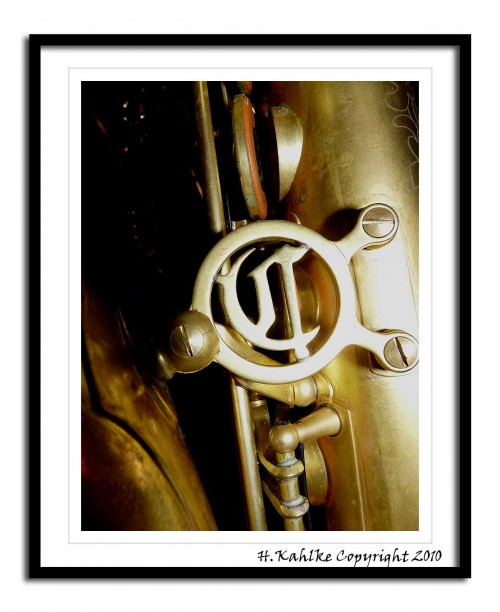In my quest for artsy saxophone pics, I shot quite a few while in a friend’s studio a couple of weeks ago. While many of them didn’t turn out—the lighting really was the shits—a few weren’t too bad.
The horn that photographed the best was the unlacquered Cannonball. This is one of my favourites. It shows the downside of unlacquered horns.





I too have a Buescher C Melody. I have the conn pictured in the photo and IT IS a straight neck, not the best of quality but the horn plays average.
It’s a very pretty C mel nonetheless regardless of its ownership history. With it being 1915, that would mean it has a curved neck, right? I’m not sure when Conn came out with the straight neck C melody horns, but I believe I read somewhere that it was later than that. Perhaps in the 20s? Mal-2, do you know for sure?
I’m really surprised that the old pads are still hanging in there. By now I would have thought that they would have turned hard as stone. My curvy Pan American has a few original pads too. They are rock hard. My poor soprano is in dire need of an overhaul. 🙁
I’m afraid I can’t help here — I’m not a fan of Conn C-mels. I own a Buescher, a broken Holton, and a parts-only Martin, but no Conn. The Aquilasax was close enough as far as I’m concerned.
and if anyone is wondering, yes, the pads are the original pads. This horn has had only 2 owners before me. One was “supposedly” John Coltrane, and the other was Bob Hoffnagle for certain. He bought the saxophone from supposedly “Coltrane” for 10$ back in 1955. Bob Hoffnagle is well in his 80’s now.
I’m still wondering if he DID buy it from coltrane. All I have is his word. It’s still nice to have the thought that it’s a Coltrane horn.
Here’s my C.G.Conn C Melody from 1915. Old but looks brand-new. 😀
I felt artsy one weekend about a 1 1/2 years ago and took tons of pics of my saxophones
You can have some fun with lighting, and it doesn’t take a whole lot of gear. Most of the lighting effects you see in commercial photographs can be done with two lights and a reflector or diffuser. Reflectors are usually simple. They may be umbrellas painted silver or white on the inside, or they may be as simple as a piece of white foamcore board or some guy holding up a towel. A diffuser is something the light passes through so it does not appear to be coming from a particular point (though the direction usually remains visible). This could again be a guy with a towel or sheet, but usually it’s frosted glass like you might find on a shower door.
For horns, especially shiny ones, a diffuser really helps to keep the highlights from getting blown out. It won’t do anything about the reflections of you and the camera showing up in the picture though. Then a second light without a diffuser is aimed at the background to generate more contrast between foreground and background.
Choosing a good background is also key. Shiny silver, gold, or lacquered horns often look their best presented against a dark background of red, blue, or purple. Black can look nice, but usually one of the colors is nicer. The opposite is true of black nickel and black lacquered horns — they look best against cream, eggshell, sky blue, and other pastel colors. Again you might imagine white would work best, but a slight tint usually helps.
Still looks gorgeous to me. :O)
Thanks Gandalfe. This is one of the better ones. I am quite fond of the shot actually… As well as the horn. If Ray ever sells her, this Mad Meg will come and live at my horn stable. Ah yes, G.A.S. rears its ugly head again… 😈